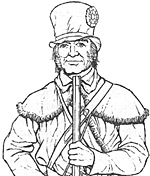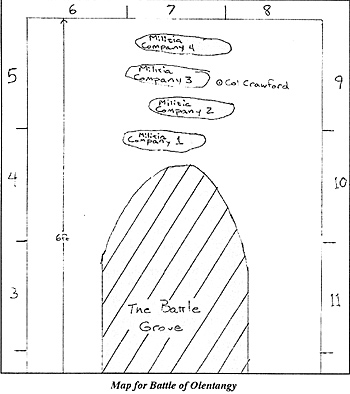 Sometimes known as the Battle of Sandusky Plains
Sometimes known as the Battle of Sandusky Plains
Introduction
On June 7, 1782, Continental Col. William Crawford led 480 western Pennsylvania militia into an ambush on the Sandusky Plains, near the Wyandot village of Upper Sandusky in central Ohio. A few months previously, these same Pennsylvania militia, under Crawford's second-in-command, Col. Williamson, had committed one of the most horrific war crimes of the American Revolution when they executed in cold blood 96 pacifist Christian Delaware men, women and children at the Moravian mission village of Gnadenhutten. The Ohio Nations were outraged and furious. When the Pennsylvanians dared to stage another Indian-killing raid deep into central Ohio, warriors gathered from all around Lake Erie and the Ohio country to take their revenge.
Surprised on the grassy Sandusky Plains by superior numbers, Crawford's men fell back to an isolated grove of trees, the "Battle Grove," and there made their stand. The Pennsylvanians held out all day, running low on ammunition and contracting dysentary from drinking polluted water they found in the woods. After night fell, they broke through the ring of Indians who surrounded their position, falling into a panicked rout and losing half their numbers in the subsequent pursuit. Crawford himself was captured and ceremonially tortured to death by the triumphant Indians, as were many of his men.
An account of this campaign and battle, and of Crawford's terrible fate, can be found in Allan W. Eckert's "That Dark and Bloody River."
 The Game
The Game
This wargame scenario is written for the rules Our Moccasins Trickled Blood. It is designed for a table at least 6'x4'. Bigger would be better; the biggest table I've played this scenario on, so far, was 9'x6', and it worked very well. The only terrain feature is the Battle Grove, which is open woods. Whatever the size of the table, keep the Battle Grove about two feet wide by four feet long, and anchored in the middle of one narrow table edge. The rest of the table is clear.
In this scenario, the Pennsylvanian player is the first player (takes the first player turn), while the Indian player is the second (takes the second player turn). The Pennsylvanian player rolls on the "Indians" line of the action table, as does the Indian player. Otherwise, all Pennsylvanian units form, move, fire and melee as ordinary militia, and all Indians likewise perform normally as per the Moccasins rules.
Game Length and Objectives
The game lasts a maximum of 20 turns. The Indian objective is to wipe out the Pennsylvanians. Friendly casualties don't impact the level of victory; the Ohio Nations want revenge.
The Pennsylvanians may not voluntarily flee off-table before the end of the game. If the Pennsylvanians break and run, the Indians will have them.
Initial Forces and Reinforcements
Pennsylvania Militia
1 Commander, Col. William Crawford
4 X Companies, each 1 Leader & 11 Militiamen
The Pennsylvania militia all start on-board in skirmish formation, as per the scenario map. The Pennsylvanian player receives no reinforcements.
At the start of the game, no Indian forces are on the table. Indian forces appear randomly every Indian player turn, as per the Indian Reinforcement Table and Indian Reinforcement Placement procedure. The Indian reinforcement table could theoretically generate nearly 400 Indians in the course of a game, but 30 to 60 Indian warriors and leaders on the table at any given time in the game is more likely. Indian casualties should be recycled as reinforcements.
Indian Reinforcement Table
- Dice Roll Reinforcement Result
2 Shaman (Commander, +2 to morale) + 1 Leader + 2d6 Warriors
3 1 Leader + 3d6 Warriors
4 3d6 Warriors
5 1d6 Warriors
6 1d6 Warriors
7 1 Leader + 2d6 Warriors
8 2d6 Warriors
9 2d6 Warriors
10 1 Leader + 2d6 Warriors
11 1 Militia Company gets dysentary (+1 to fire, -2 to melee) + 2d6 Warriors
12 1 Militia Company gets dysentary (+1 to fire, -2 to melee) + 1 Leader + 2d6 Warriors
Notes:
1. Shaman. An Indian Commander, he can form and command a warparty of up to 20 warriors. Can attach to a warparty that already has an ordinary leader. Adds +2 to the morale of the warparty to which he's attached. Otherwise functions as an ordinary leader for command, melee and casualty determination. Only one Shaman may appear per game. If 2 is rolled for reinforcements a second time in a game, the Indian player receives only 1 Leader + 2d6 Warriors as reinforcements for that turn.
2. Dysentary. When the Indian player rolls an 11 or 12 on the Indian Reinforcement Table, one militia company may (or may not) get dysentary from drinking bad water. The Indian player assigns a number, starting with 1, to each militia company remaining in the game. Then the Indian player rolls 1d6. If the dice roll corresponds to the number of a militia company, that company gets dysentary for the rest of the game. Mark the afflicted company in some way (I've made up some little brown puddles). All members of that company now suffer a +1 penalty to their musket fire dice rolls, and a -2 penalty for melee. If the number rolled on the d6 doesn't correspond to a militia company, or if the company already has dysentary, the roll has no effect. The Indian player still receives his reinforcement for the turn.
Indian Reinforcement Placement
At the beginning of each Indian player turn, the Indian player rolls 2d6 to determine a result on the Indian Reinforcement Table. The Indian player then rolls 1, 2 or 3d6, as specified, to determine how many warriors he receives. The Indian player again rolls 2d6 and places the warriors, and any leaders specified, in the corresponding numbered section of the table edge (see scenario map). Finally, the Indian player rolls one more d6. The number rolled on this last dice is the number of inches in from the table edge that this group of reinforcements is placed. Reinforcements may be placed in any legal formation or in disorder, anywhere in the specified sector of the table within the specified distance from the table edge, by the Indian player.
Once reinforcements are placed, the Indian player rolls on Moccasins Table 1 "Operation Determination" and the Indian player turn proceeds normally.
Indian Leaders and Warpartys
Many Indian reinforcements appear without a leader. As per the Moccasins rules, units without a leader cannot move, change facing and/or formation, charge, or rally or reform. Leaderless units may only fire and load.
When a leader appears as a reinforcement, he can immediately take command of leaderless warriors in that sector of the table and add them to his warparty. However, a leader may not move to leaderless warriors in a different sector of the table and take command of them, or add more warriors to his warparty on later turns. Also, no warparty may number more than 14 warriors and 1 leader. Warriors in excess of that number must be left leaderless. As an exception, the Shaman may attach to a warparty that already has an ordinary leader, and the Shaman's warparty may number up to 19 warriors and/or leaders, plus the Shaman himself.
This amorphous nature makes it difficult to determine when an Indian warparty has reached half-strength. To keep track, note the original strength of each warparty on a small slip of paper that stays with those warriors. Don't worry about the original strengths of leaderless groups of Indian reinforcement figures. If a leaderless group of Indian reinforcements is somehow attacked, it probably won't stay on the table long enough to reach half strength.
Baselines and Retreat Paths
The narrow edge of the table that is unnumbered (see scenario map) is the Pennsylvanian baseline. Involuntarily retreating Pennsylvanian units move as quickly and directly as possible toward their baseline and off-table. The 3 edges of the table that are divided into sectors and numbered on the map are the Indian baseline. Involuntarily retreating Indian units move as quickly and directly as possible toward the nearest friendly table edge and off-table.
Units that retreat off-table are permanently removed from the game, and are considered destroyed. An involuntarily retreating unit may skirt a hostile force that blocks its direct retreat. However, if a unit that must retreat is surrounded, it surrenders (not a good idea at this battle) and is permanently removed from the game.
Designer's Notes
In designing this scenario, I was inspired by Terry Pilling's "Custer's Luck," a wargame of Custer's Last Stand. Custer's Luck was published in Midwest Wargamers Association Newsletter #121. I lifted several useful rule mechanisms directly from Terry's article.
If anyone counts noses, they will see that I'm representing the 480 Pennsylvanians at a ratio of 1 figure = 10 men, instead of the 1:15 ratio that's standard for Moccasins. I did this for convenience, because I think a smaller force of Pennsylvanians would make a shorter, duller game. It's a wargame, not a perfect scale model.
Players should be careful that they have enough room to retreat without going off-table, in the event of a morale failure. The Indians especially will suffer from this effect, since they must retreat toward the nearest friendly table edge, regardless of which table sector they first appeared in. It is anticipated that a large portion of losses in this game will result from units retreating off-table.
It is anticipated that many leaderless Indians will spend the whole game hanging around uselessly near the table edge. Contrariwise, an Indian leader may appear in a marginal sector with as few as 2 warriors. Those are the breaks!
Olentangy is not necessarily a balanced, competitive wargame scenario. The Indian player is severely restricted by the reinforcement rules. The Pennsylvanian player must deal with the mental pressure of a last stand. I wouldn't spring this scenario on anyone as a surprise. But two or more players who are prepared for the situation may find it makes an entertaining game, if not perfectly balanced.
The historical outcome of this battle is that the Pennsylvanians successfully held out until nightfall. In game terms that's a victory for the Pennsylvanians, though the final result was still disasterous for them. I have tried to balance this scenario so that the odds slightly favor a Pennsylvanian victory. To be successful, the Pennsylvanian player must scramble into the Battle Grove as fast as possible, and establish a defensive position. He will do well to keep the Indians out of the woods as long as he can, since Indian morale increases sharply in woods, and they also benefit from cover. He should keep a reserve.
But the Pennsylvanian doesn't have enough troops to cover the entire perimeter of the Battle Grove. If he falls back to shorten his lines, he gives up room for retreat. The Indians move faster than his militia and can work around his open flanks. While he considers his unattractive options, the Pennsylvanian player watches increasing numbers of Indians build up, mill around, run circles around his position, make dashes at his lines...and then his men start going down with dysentary! Hey GM, what turn is this?! While inflicting this mental torture on the Pennsylvanian, it's my intention that the Indian player's ability to strike the Pennsylvanians should be largely frustrated by misplaced reinforcements and scanty leadership.
Back to The Herald 54 Table of Contents
Back to The Herald List of Issues
Back to MagWeb Master Magazine List
© Copyright 2003 by HMGS-GL.
This article appears in MagWeb.com (Magazine Web) on the Internet World Wide Web. Other articles from military history and related magazines are available at http://www.magweb.com